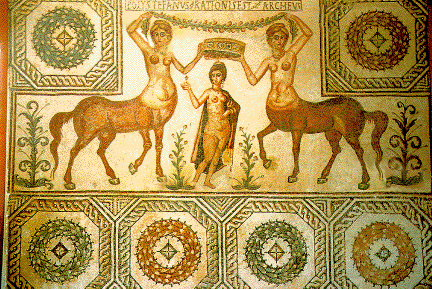Karl Pribram and I were invited to attend the first Centaur inaugural ceremonies, and subsequent congresses in Knoxville, Tennessee—fittingly held each year on April 1st, a date that is traditionally associated in Greece with the birth of Chiron, perhaps the world’s most famous centaur, as teacher to Herakles and Asklepios. My own schedule, to-date, has only permitted me to participate peripherally in these proceedings through remote field work described below.
In 1992, with great pomp and circumstance, the University of Tennessee received the ancient bones of the legendary Centaur of Volos. A gift of Professor William Willers of the University of Wisconsin, the bones had been in the possession of that institution since the mid-1980s, and the means of their discovery is in itself a fascinating story which can be explored in depth on the website of the fomer university’s Interdisciplinary Studies Program. The remains of the Centaur of Volos are now installed, and can be visited by travelling scholars, in the Great Hodges Library on the campus of the University of Tennessee at Knoxville.
Much has been written about the centaurs from early times, more than enough to form a good picture of how they were regarded by their contemporaries in antiquity. Apart from their well-known role as educators and healers, my own interest in centaurs was first captured by the deep symbolism inherent in their biological makeup—part man, part horse, a combination of man and beast—a dichotomy that was not ignored by the ancients, any more than by contemporary writers like Robert Graves, Carl Jung, and Thomas Mann. This two-in-one holistic dualism makes the centaur almost a walking (or galloping) prototype of the alchemical marriage, the ancient initiation process known to all cultures, the purpose of which was to conceptualize and make concrete the link between spirit and matter, the yolk and the white, the yin and the yang. But despite the power and presence of the centaur in early writings—or perhaps because of the almost mythological stature of some of this species—most scholars today have tended to regard the centaur as a fantasy being, like fairies or dragons, and many continue to do so, even today despite the weight of physical and scholarly evidence.
Female Centaurs crowning Venus in the Bardo Museum of Tunis
Photo: Katherine Neville
It was during a Christmas research trip to North Africa, in 1997, that I came upon the large mosaic depicted here. The mosaic itself is part of the huge display at the Bardo Museum of Tunis, collected from Roman sites all across Tunisia. This lovely and impressive work of hand-cut tiles depicts two young female centaurs holding aloft a golden crown which they are about to place on the head of Venus—the goddess who is also known by her older Greek name: Aphrodite, the foam-born.
This mosaic may be unique, in its subject matter, from any artistic representation throughout history—according to current opinion, it is the only major work of ancient North African art portraying centaurs, and perhaps the sole ancient work portraying two female centaurs. But due to its peculiar subject matter, the mosaic might also contain the key to an ages-old mystery. This led me to return, the following winter, to help unearth something of the history of the region where the mosaic was found, and its connection to even earlier cultures.
The mosaic itself was brought from the Roman baths at Thurburbo Majus, which in Roman times supplied water to the coast by the use of an elaborate system of aqueducts that crossed the great Atlas mountains. The city of modern Tunis, at the northernmost tip of the African continent, was once the ancient Phoenician city of Carthage. According to legend, Carthage was founded by Dido, queen of Tyre in Phoenicia, who sailed across the Mediterranean seeking refuge when her brother killed her husband. Dido later died by immolating herself on a funeral pyre due to her unrequited love for the hero Aeneas, who’d deserted her. This echoes the earlier story of Ariadne—daughter of King Minos of Crete and sister of the Minotaur. Ariadne hanged herself when she was deserted by the hero Theseus. One death was therefore by fire, and another suspended on a tree beneath land and sky—earth and air. (Ariadne herself was often symbolized as a mountain containing a labyrinth—reinforcing the connection between earth and sky.) The fourth and final element for the ancients was water—assocated with life renewal, fertility, and Aphrodite.
In summary, we have two centaurs—representing through their own beings the alchemical mix of spirit (air) and matter (earth)—and they are in the act of crowning Aphrodite, the foam-born, who represents water, the picture itself having been created for the Roman baths at Thurburbo Majus that supplied water to the city founded by Dido—queen of fire. So in one picture, we have connected the four major elements sacred to the ancients. What does it mean that they are portrayed by a cast of all-female actors?
The trail was soon to be revealed in my subsequent trip to Tunisia, with Karl, during the month of Ramadan over New Year¹s of 1998-99. The answer involved a grab-bag of clues, both ancient and modern, that proved to be interconnected. These clues provided answers including, but not limited to, the following:
- What was the meaning of the specific location of Carthage, and its proximity to Sicily and Malta, in ancient times?
- What was the significance of the female horse to early goddess cultures around the Mediterranean?
- What was the secret history of the mysterious archaeologist who first discovered the remains of the Centaur of Volos?
- Who was the even more mysterious woman, named Sabrina, whom he met in North Africa—and what did she reveal to him there?
